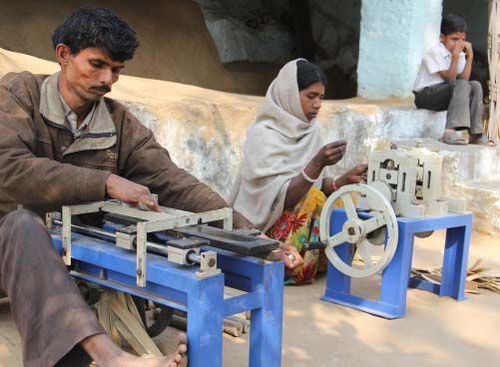1.Mitticool: A refrigerator that runs without electricity
The Mitticool Fridge was developed and launched by Indian engineer, Mansukhbhai Prajapati (pictured), in 2006. Made entirely from clay, the device costs roughly $50 and uses no electrical power. It can keep items of food fresh for up to five days and has been a valuable addition to rural communities in India.
2.In consultation with local communities, Frugal Digital developed Darshana, a low-cost lunch box projector for use in schools. The projector is fitted with a small USB 2.0 port and uses a phone touch screen as a trackpad
3.GE’s Vscan is a pocket-sized ultrasound device being utilized in both developing and developed regions of the world. Launched in 2010, the hand-held tool costs just $7,900 (compared to traditional ultrasound consoles which can cost as much as $150,000) and has improved access to advanced prenatal care in areas of rural China, India and Africa.
4.Mehtar Hussain and Mushtaq Ahmed from Assam built a bamboo windmill for around $100 to pump water from a small padi field. The invention has now been adopted by Gujarati salt workers, who are some of the poorest people in the state, to pump brine water. Petrol-powered pumps consume huge amounts of fuel, at a cost of around $1,000 each year. The wind-powered pump runs at a fraction of the cost.
These brothers, Mehtar Hussain and Mushtaq Ahmed Dar, designed the Bayukal.
5. Paresh Panchal’s bamboo splint-making machine makes it possible for people in isolated villages to make incense sticks at low cost. The machine was awarded at the 7th annual presidential grassroots innovation awards in March, 2013.
Bamboo splint making has been done manually for years using knives, which is a verytedious, time consuming and risky method. The innovators have developed a manual machine, which can slice bamboo strips and also make splints from the strips. One needs to load the bamboo piece onto the machine and slide the cutter to and fro using a handle. This results in 1.2 mm thin strips of bamboo. About 50 of these strips are then stacked together and loaded onto the machine vertically. The cutter is again moved to and fro resulting in splints of 1.2 mm thickness.
6. Professor Anil Gupta shows Hollywood film director James Cameron a biomass gasifier invented by Raj Singh Dahiya. Dahiya was born into humble circumstances, but taught himself engineering from a young age. The gassifier — developed over 20 years — creates fuel from farm waste bringing power to otherwise isolated areas of the country to light houses, filter water, and run mills.
7. Mansukhbhai Jagani’s motorcycle-based tractor is both cost effective — costing roughly $318, and fuel efficient — it can plow an acre of land in 30 minutes with just two liters of fuel.
8. D. Renganathan developed a mechanical tree climber which can be used for scaling palm and coconut trees. Climbing trees for harvest is difficult and dangerous work — the tree climber designed by Renganathan uses a ‘four-lock pin’ system to prevent falls. The device now sells across south Asia.
9.Frugal Digital also developed Clock Sense, a monitor converted from an old alarm clock which can easily assess temperature, pressure, pulse, oxygen saturation, respiration rate, blood sugar. It is cheap to produce and can be assembled from components which are easy to find across India. The indicator provides simple information: red means the patient should be taken to the hospital immediately, yellow indicates that an appointment with a doctor should be made, green indicates good health.
10.Staff monitor a ward of a Narayana Hrudayalaya clinic in southern India. Somewhere between Walmart and a low-cost airline, the chain of medical centers aim to bring affordable healthcare to the masses. The organization’s founder, Dr. Devi Shetty, even believes he will be able to conduct heart surgery for as little as $800 (compared to as much as $100,000 for the same procedure in some hospitals in the U.S.)
11.A woman is interviewed by a citizen journalist for for CGNet Swara, a voice portal that allows rural Indians to dial-in via their mobile phones and listen to local news reports for areas where there is often little media coverage.
12.Indian prosthetics organization, BMVSS, say they can produce an artificial limb for as little as $45. This compares to upwards of $10,000 dollars for a similar procedure in the U.S. Thousands of Indian amputees who would otherwise be unable to afford expensive medical procedures have benefited from BMVSS and their “Jaipur Foot” program since it was established in 1975.
















1 Comment
mitticool refrigrator amazing empliment..
mitticool manufactual procedure send my email plz prajapati sir…